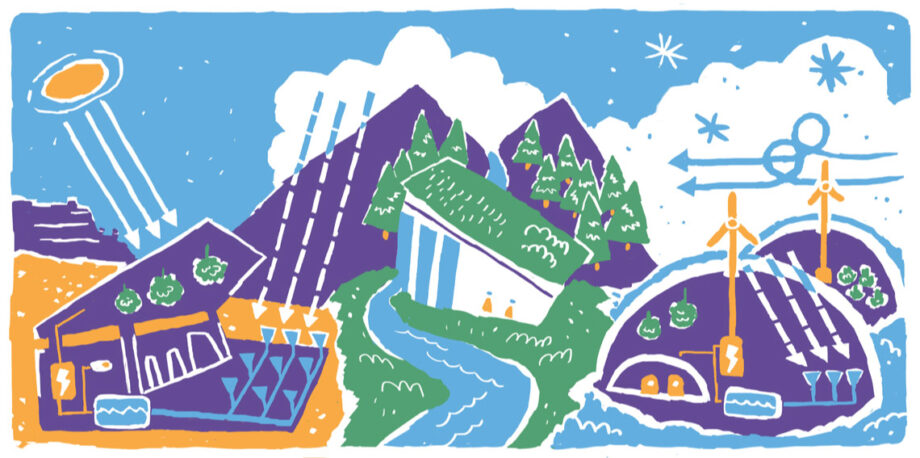May 21, 2013 — Journalist and activist Jane Jacobs, infamous for her David-and-Goliath fights against powerful New York City bureaucracies, noted in her influential 1961 book, The Death and Life of Great American Cities, that sentimentalizing nature was dangerous. Why? Because people express a desire to preserve nature, when that desire is really to preserve an idea of nature so one-dimensional that it is defined as grass and trees and, well, that’s about it. This “schizophrenic attitude” leads to “several thousand more acres of our countryside … eaten by the bulldozers, covered by pavement, dotted with suburbanites who have killed the thing they thought they came to find,” Jacobs wrote. City parks and suburbs wipe away complex woodlands (nature) for sprawling lawns (still nature) with who-knows-how-many chemicals in them.
A similar dichotomy can be found in our built environments. We construct false environments of glass walls for light and filtered air to breathe, failing to see the complex connections between individual building systems, larger infrastructure and the environment.
Meanwhile, the battle cry for environmentalism is to “Go Green!” But going green has also become schizophrenic, developing into a random application of solar panels and wind turbines — a valiant but limited effort in resource renewal. Promoting underdeveloped technologies that pollute and expend a great amount of resources during their production is not using current and natural processes to promote real change. So it can be dangerous to “Go Green!”
What if architecture, a traditionally static and independent entity, became systemic? What if each structure considered the one next to it and the one next to that?
We need a more unified mindset around which to develop our built and networked infrastructure so it is concurrent and integral with nature. One that represents the complex yet balanced system that has evolved and adapted for ages, unlimited as an informed and evolutionary feedback loop. Nature is not slapping a solar panel on a flower because it is not producing enough chlorophyll or a wind turbine powering an alarm clock for a bear to wake from hibernation. More appropriate models are found in biomimicry, based on the complex interaction of nature and information as a seamless whole composed of countless scales and relationships. Janine Benyus, founder of the Biomimicry 3.8 Institute, notes that biomimicry can inform all systems, from building and services to social models and economics, that thrive on participation and interaction. The biomimicry model is dynamic, where conventional infrastructure is limiting and inflexible.
What if architecture, a traditionally static and independent entity, became systemic? What if each structure considered the one next to it and the one next to that and changed regionally and geometrically, undulating and responding to its surrounding environment, information and feedback loops? Form, in turn, would be multifunctional.
The geometry of a structure should be dictated not by a cookie-cutter manual, but by the resources of the region. In northern latitudes, for example, it may seem counterintuitive to see snow as a resource, but a structure that captures and maintains a snowpack can supply insulation from the thermal mass of snow throughout the cold winter months, while slowly shedding it as the temperatures warm. In a warm, dry climate such as the American Southwest, it would make sense instead to have a structure that collects and stores rainwater for the driest months.
As Benyus notes, biomimicry is not the same as bio-assisted processes. It’s not about using oysters or tilapia to clean polluted waterways. Instead it is about using information within a decentralized, connected network that neither gives nor takes more than it can sustain.
With building materials constituting up to 40 percent of the waste in landfills [pdf] across the U.S., it’s clear we need to think differently about how we build. In mimicking how nature builds we could develop a structure out of natural proteins, for example, that when doused with seawater creates a lasting and natural hollow structure that could be used to pipe collected water throughout the structure. The latticed “shell” could act as a base for planting vegetation with roots penetrating the “pipes” to reach the water, creating a hydroponic system to grow food while simultaneously providing thermal mass (added to the thermal mass of the water in the piping) for insulation. Protruding structures could be designed into the form to capture rain, modeled on the papillae of a bat’s tongue, which increase in size during feeding to make nectar collection more efficient. Simultaneously these protrusions could collect energy from the water passing over and around them.
Or what if we used a passive model such as soil for a building material, filling the cavity of a building envelope and developing a system similar to composting? During the winter you would combine the soil and worms with food waste, sewage and gray water from the structure to create compost. The by-product of breaking down organic compounds is heat, which could supply warmth and energy to the structure (or even roast a turkey!). In the summer the system could be emptied and the soil used for gardening or small-scale farming. The empty building envelope would then act as a trombe wall for air circulation during those warm months.
In these examples, we see not only the technologies that could be capitalized upon as regional resources change, but also the heart of the issue: There are multiple ways to address the complexities of built environments, and we are given countless examples to follow in nature. Design presents a multitude of “coulds” and “woulds,” but the beauty of the system is that possibilities, like natural processes, are endless.
So, it is ultimately not about protecting the environment — to “Go Green” and treat nature as a simple, pathetic creature. Instead, it’s about learning from the complex ecosystem of which we are a part. After all, the natural world has a fascinating breadth of examples if we are willing to explore beyond just the green. There is no silver bullet solution to challenges designers and architects face. Instead there are redundant, simultaneous, independent and endless solutions working for the whole. ![]()
Editor’s note: The views expressed here are those of the author and not necessarily of Ensia. We present them to further discussion around important topics. We encourage you to respond with a comment below, following our commenting guidelines, which can be found here. In addition, you might consider submitting a Voices piece of your own. See Ensia’s “Contact” page for submission guidelines.
Ensia shares solutions-focused stories free of charge through our online magazine and partner media. That means audiences around the world have ready access to stories that can — and do — help them shape a better future. If you value our work, please show your support today.
Yes, I'll support Ensia!

I live in Florida and the state of Florida has 21 million people in it, over half the population of Canada. The land that has been stripped to build housing developments has made my county almost unrecognizable.